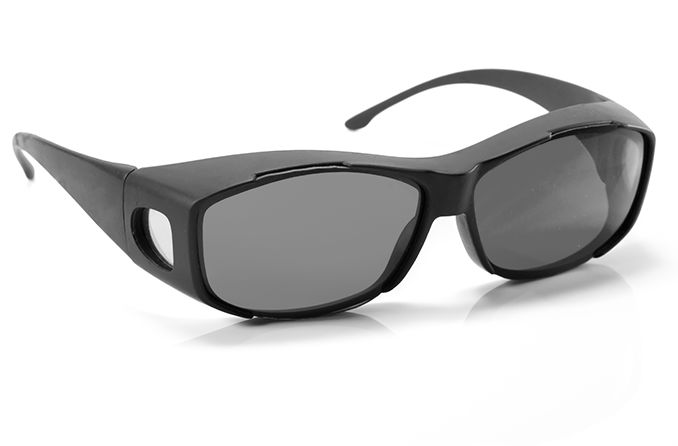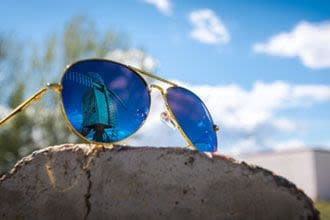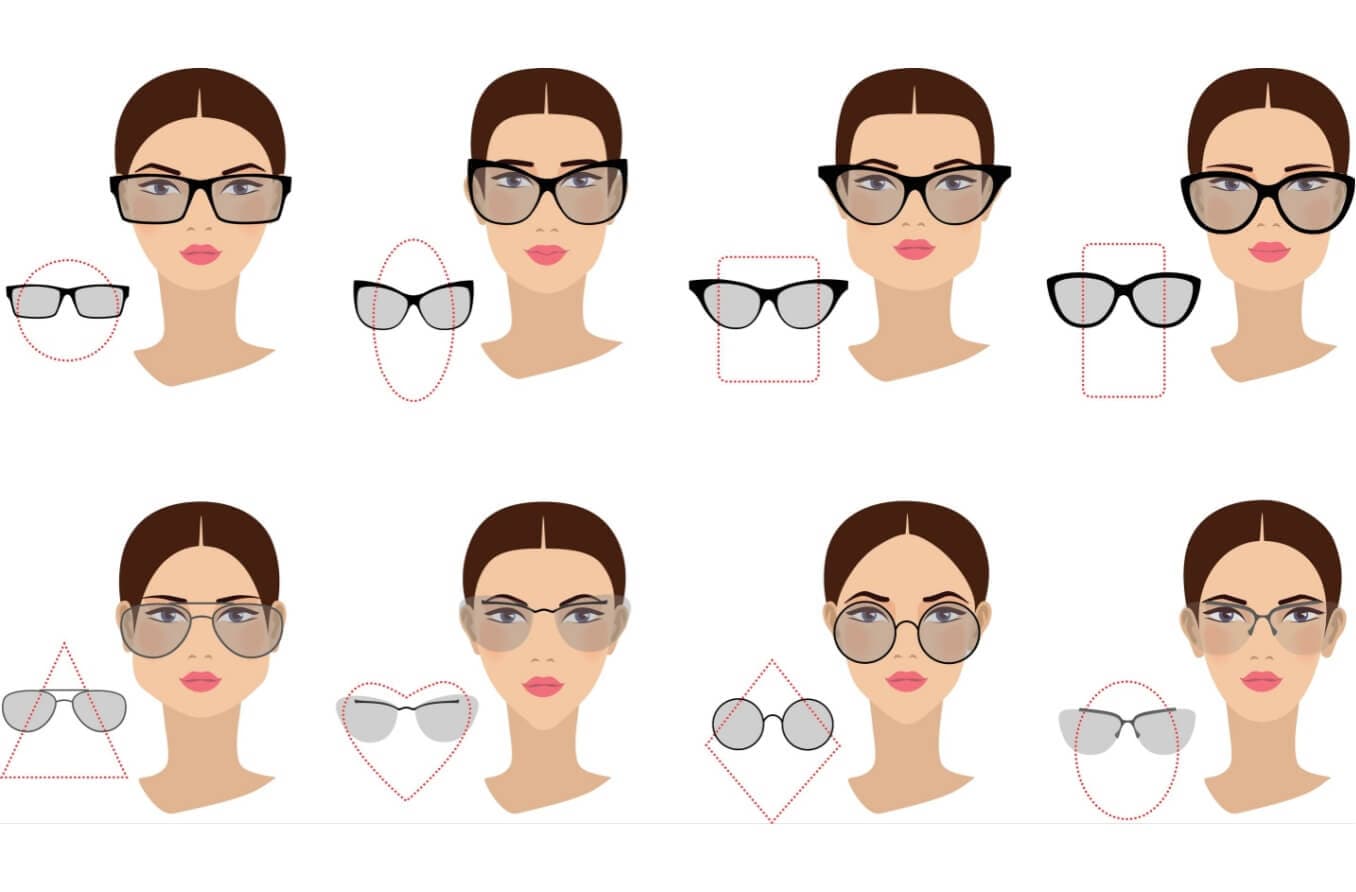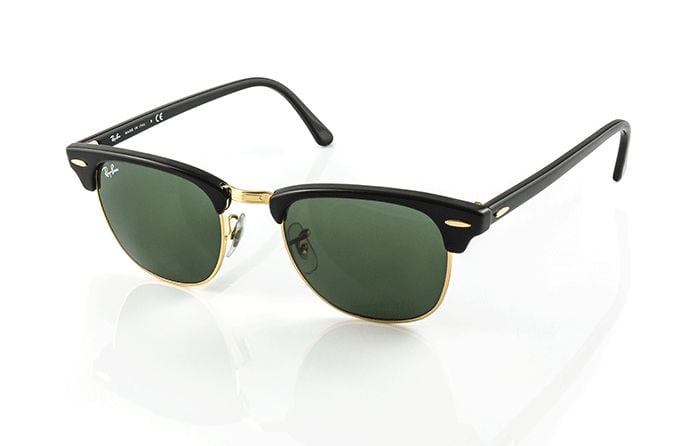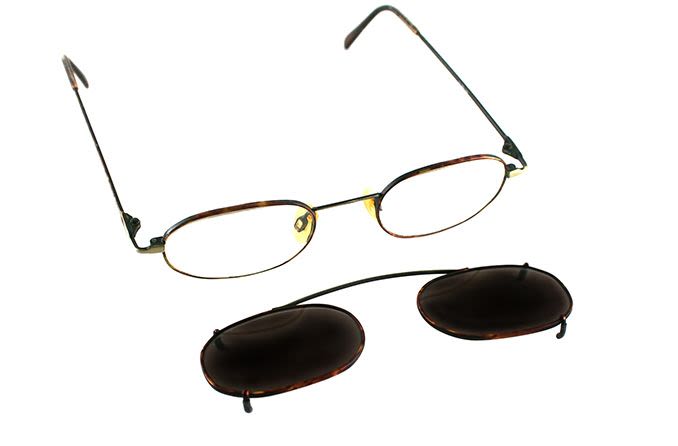Fit-over sunglasses are exactly what their name implies: They are sunglasses that fit right over your regular prescription glasses. Designed to achieve a snug fit around the frame size (and style) of your current glasses, fit-over sunglasses offer you an affordable, effective and practical alternative to prescription sunglasses.
Certain fit-over sunglasses offer additional features that can further protect your eyes from harmful ultraviolet (UV) rays and reduce eye strain, including polarized lenses (with a special anti-reflective coating that blocks glare) and side shields (lenses along the side of the glasses that block sunlight).
How fit-over sunglasses protect your eyes
Fit-over sunglasses work like any other shades, and you’d wear them for similar reasons — primarily, protecting your eyes from sunlight. UV rays can cause damage to the surface tissues, corneas, lenses and retinas of your eyes. Over time, this kind of damage can increase the risk of developing more serious problems, such as cataracts or macular degeneration.
Protecting your eyes from sunlight is essential year-round — after all, your eyes are vulnerable to UV damage even on an overcast day or in winter, when the sun can reflect off ice and snow. But this isn’t always so simple if you wear prescription glasses, as you can’t just walk into a drugstore and buy sunglasses off the shelf. If you enjoy spending time outdoors in the sun and you need — or would prefer — to wear your glasses, you need a solution, and fit-over sunglasses may be just right for you.
SEE RELATED: What are clip-on sunglasses?
Fit-over sunglasses vs. prescription sunglasses
There are two basic sunglasses options for people who wear eyeglasses: fit-over sunglasses and prescription sunglasses. Both offer protection against the sun and vision correction; however, there are scenarios in which one type may be more appropriate than the other, and certain advantages to each type to keep in mind:
- Fit — Prescription sunglasses are custom-made for you, so they may be more comfortable. Like your regular prescription glasses, prescription sunglasses will fit snugly on your face, come in a wide variety of styles and are crafted specifically for your needs. Prescription sunglass lenses can also fit into any style of frames, regardless of whether or not they are specifically sold as sunglasses frames.
- Price — Prescription sunglasses are often just as expensive as buying a new pair of regular eyeglasses, depending on the cost of the frames and any added features or lens coatings. Fit-over sunglasses are much more affordable. In fact, they’re so inexpensive, you could buy multiple pairs to keep at home, in your car and in your purse or tackle box, for the same cost as a single pair of prescription sunglasses.
- UV protection — Fit-over sunglasses can offer better protection for your eyes by blocking light from the top, bottom and sides of the frame, due to their larger size and their snug fit around your prescription glasses. Certain styles of fit-over sunglasses may even include side shields, which are lenses along the side of the glasses that block sunlight. This provides you with better protection from the sun — making them an ideal option for people with light sensitivity or those who spend a lot of time outside in bright sun.
- Fashion — Fit-over sunglasses aren’t an exact match for sunglasses. Despite many fashionable fit-over sunglasses available that appear as if you’re wearing regular sunglasses instead of two pairs of glasses, the reality is that fit-overs do add some bulk to your look. If that is a problem for you, prescription sunglasses may be a better option.
- Safety — Fit-over sunglass lenses can be made more impact-resistant than prescription lenses. Their thicker frames also offer another layer of durability. This can be important if you are using fit-over sunglasses when exercising or playing sports outside.
- Comfort — Fit-over sunglasses add weight to your glasses. The additional weight may mean that your glasses slide down your nose more easily. However, selecting a lightweight pair of fit-over frames and measuring accurately for the right fit can significantly reduce this issue.
Looking for a more convenient option? Photochromic lenses, also called transition or light-adaptive lenses, darken when exposed to UV rays, meaning you only need one pair of glasses to protect your eyes from the sun.
Polarized fit-over vs. non-polarized fit-over sunglasses
If you’ve determined that fit-over sunglasses are the right choice for you, the next question is whether or not you want polarized fit-over sunglasses. While all tinted lenses reduce brightness to varying degrees, polarized sunglasses specifically limit glare from sunlight and other light bouncing off reflective surfaces like metal or water.
They work like this: Polarized lenseshave a special chemical coating that blocks all horizontal light while allowing vertical light to get through. This means that the image you see with polarized lenses looks a bit darker than usual — that is, the glare is gone. Objects will appear crisper and details are easier to see because they’re not blocked by glaring light, ultimately giving you clearer vision with less eye strain.
One downside is that polarized lenses block horizontal light, so they can make LCD screens (phones, tablets, some dashboard displays in cars, etc.) harder to read. Polarized lenses can also be more expensive — fit-over polarized sunglasses are no exception. So if you tend to read your phone while you’re out in the sun, non-polarized fit-over sunglasses may be a better choice.
If you are looking for fit-over lenses to help protect your eyes while you’re out on the water or snow doing activities like fishing or skiing, polarized lenses can offer superior and necessary glare reduction and sun protection.
Fit-over polarized sunglasses for fishing
Polarized fit-over sunglasses are particularly popular for fishing, where glare reduction, eye protection and clear vision are paramount. This is why so many fishers who need eyeglasses turn to polarized fit-over sunglasses. The polarized sunglasses block any glare reflecting off the water, and the snug fit over the top, bottom and sides blocks sunlight from sneaking in places that regular sunglasses would miss.
While some brands of fit-over polarized sunglasses are explicitly marketed as fishing sunglasses, any polarized fit-over sunglasses will work. Fishers may want to consider more durable and lightweight designs that don’t add much extra weight, while still being tough enough to withstand the rigors of a day of fishing.
Fit-over blue-blocker glasses: Another option
While these are not sunglasses, blue light filtering glasses (also sometimes called blue blockers) function in a similar way — they reduce exposure to blue light. Fit-over blue light glasses are becoming increasingly popular for the same reason that fashionable fit-over sunglasses are popular: They allow you to wear your regular prescription eyeglasses while also filtering blue light both indoors and outdoors. If you’re interested in reducing your exposure to blue light, fit-over blue light glasses may be another option worth exploring.
More features to consider when selecting fit-over sunglasses
While polarized lenses are an important feature of sunglasses, there are other things to consider when you’re selecting fit-over sunglasses. For instance, impact resistance may be a priority for you, while others may seek a wraparound style for maximum sun protection. Options to think about when selecting fit-over sunglasses include:
- Tint — The tint of your glasses doesn’t make a difference in how the glasses block that UV light; however, tinted or colored lenses do offer different benefits. For example, gray-tinted lenses may help further reduce glare and work well in all weather conditions, which can be helpful when driving. Yellow-tinted lenses, meanwhile, provide better depth perception and improve visual acuity, which is helpful when playing sports.
- UV protection — Look for fit-over sunglasses that block 99% or 100% of all UV light. Sometimes sunglasses are labeled UV400 — this means the same thing; they block 99% to 100% of UV light.
- Impact resistance — If you plan to wear fit-over sunglasses while being active, look for more impact-resistant sunglasses that are made from sturdier materials.
- Lens darkness — While a medium-dark lens is good for everyday use, if you are regularly in bright conditions or have light-sensitive eyes, you may want a darker option. This is just for your own comfort, as there is no correlation between lens darkness and UV protection.
- Wraparound fit — Some fit-over sunglasses are wraparound glasses, meaning the lens wraps uninterrupted from the front to the side of your head, offering more protection without breaking your field of vision. Side-shield fit over sunglasses achieve a similar effect and are an alternative to wraparound fit-over sunglasses.
How to measure for fit-over sunglasses
To ensure that your fit-over sunglasses actually fit over your sunglasses, you will have to look for the right size and style for the prescription glasses you have. Measuring for fit-over sunglasses is a relatively simple process that requires just two measurements: the width and height in millimeters of your prescription eyeglasses. For the best fit, your fit-over sunglasses frame should be slightly larger in width and height than your eyeglasses. You may also want to consider measuring the width of the bridge of your nose to get a more accurate size.
Then, consider the style. Square fit-over sunglasses, for instance, obviously won’t look right over round glasses. The exact curve of the frames doesn’t have to match perfectly, as long as your fit-overs measure a few millimeters greater in the width and height.
Where can I buy fit-over sunglasses?
You can buy various fit-over sunglasses brands at a number of places, including big-box retailers and specialized eyeglasses retailers. Some of the best-known retailers for fit-over sunglasses are:
- Frames Direct
- Pearle Vision Centers
- Big-box retailers like Wal-Mart and Target
- Online retailers like Amazon
- Pharmacies such as CVS and Walgreens
Can I use vision insurance to purchase fit-over sunglasses?
Depending on your vision insurance benefits, fit-over sunglasses may be partially covered by vision insurance. Some insurance providers offer discounts on non-prescriptive sunglasses, such as fit-over sunglasses. Contact your vision insurance provider for more information.
Best fit-over sunglasses — what’s right for me?
To determine the best fit-over sunglasses for you, ask yourself the following questions.
- Are you looking for fashionable fit-over sunglasses or for a specific purpose or activity, such as fishing, playing sports or hiking? Are looks or function more important to you?
- Do you spend a great deal of time outdoors? What do you do when you’re outdoors? For example, is your activity level high, like running, or low, like laying out on the beach? How much movement is involved in your outdoor activities?
- Do you feel like sunglasses alone do not provide adequate protection for the sun?
- Do you dislike wearing contact lenses and prefer to wear your regular prescription glasses, even when outdoors in the sun?
- Do you need your glasses to drive?
- Do you feel like your current glasses or sunglasses don’t block enough glare? Would polarized fit over sunglasses fix that problem?
Fit-over sunglasses are ultimately about protecting your eyes when you’re outside, while allowing you to wear your regular glasses, so be sure to opt for sunglasses you’ll actually wear. Taking the above questions into consideration can aid you in deciding which fit-over options are right for you.
SEE RELATED: Choosing the best sunglasses for your active lifestyle
